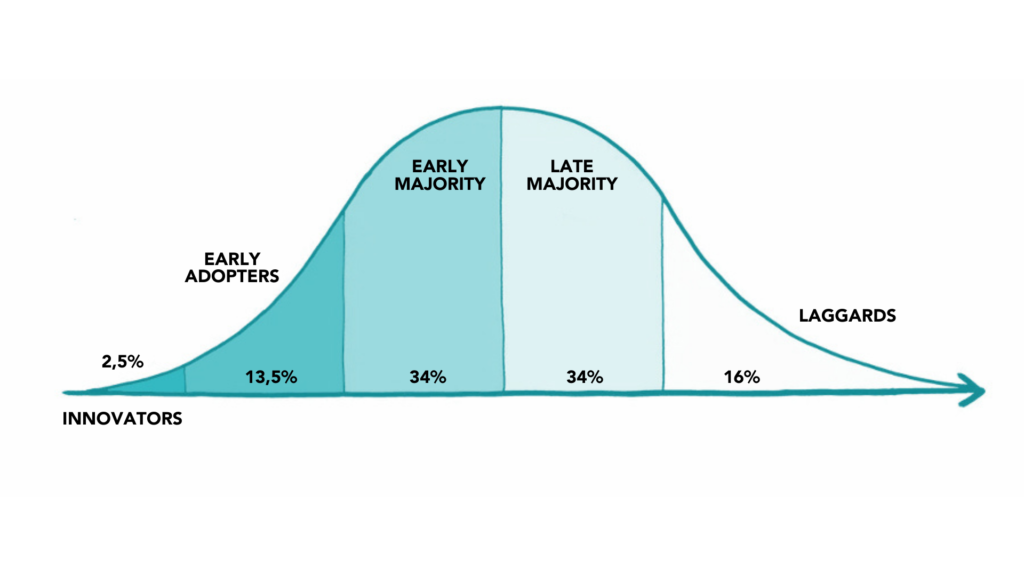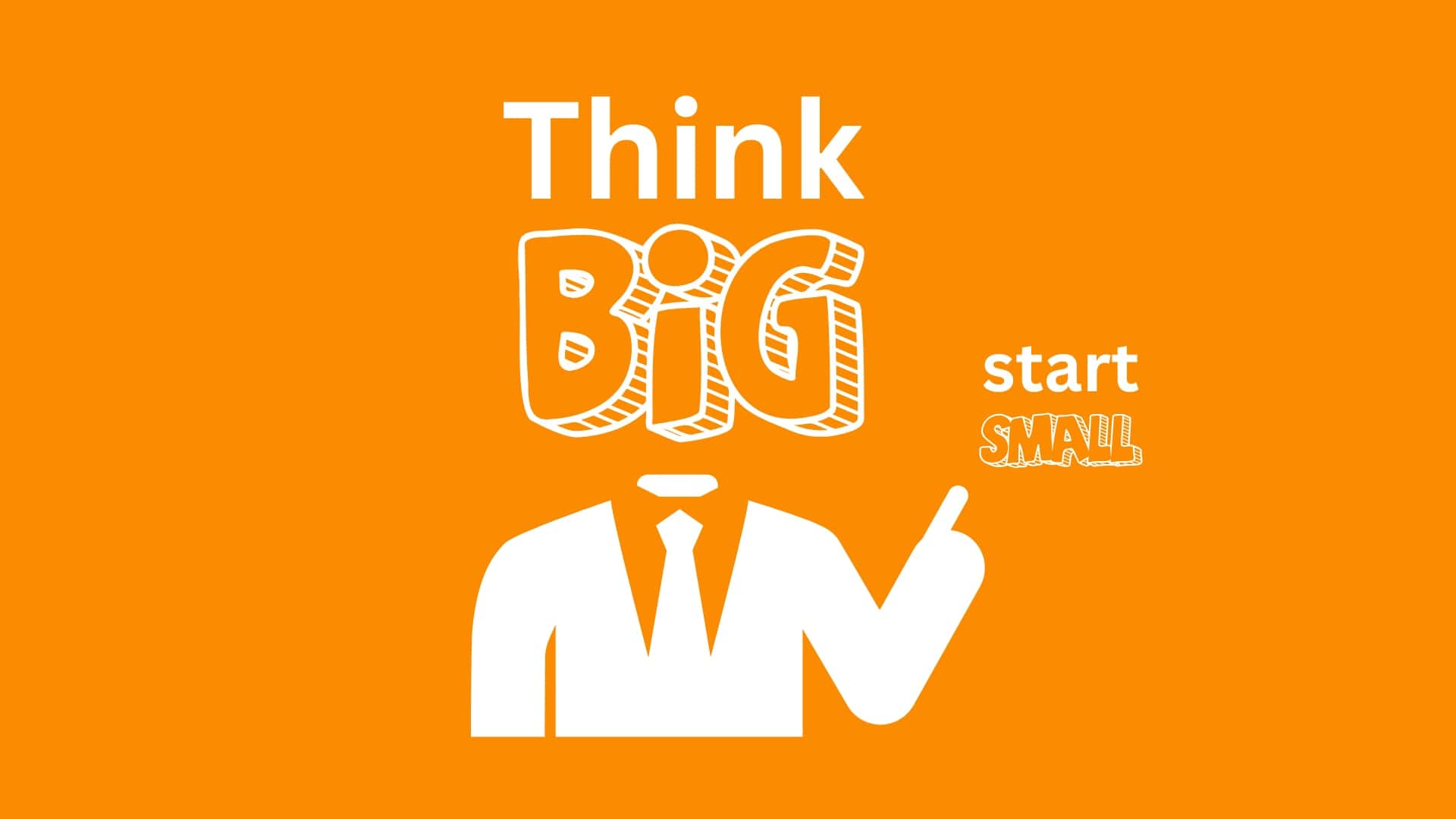Strategic innovation is paramount to stay relevant
As the business landscape continues to evolve at an unprecedented pace, strategic innovation becomes paramount. The principle “Think big, start small, and validate before you invest” encapsulates a methodology that minimizes risks, optimizes resources, and ensures investments align with customer demands. In today’s disruptive and global business environment, you must be willing to disrupt yourself, or someone else will. If you only keep doing what you have always done, you can quickly fall behind. Well-known companies like Kodak, Blockbuster and Nokia are good examples of how dangerous this can be.
Think big. Start small. Scale fast.
– Eric Ries
Thinking big
Thinking big involves envisioning transformative ideas that have the potential to reshape industries.
If you have not read our article “Start with why and measure what matters,” I recommend you do so to fully understand the importance of thinking big. A clear purpose and vision that is understood by both customers and employees is powerful in making the vision a reality. Employees will know what they can do to help move you closer to your goals, and customers who align with your purpose will become ambassadors for your business.
Thinking big is essential. However, the key to delivering fast enough to hit windows of opportunities that open and close faster than ever before is to break down these ambitious ideas into smaller, manageable components. Small batches that can be developed and delivered fast to customers. This approach mitigates risks, fosters adaptability, and facilitates a more focused and effective development process.
Starting small
Delivering in small batches means finding small parts of value out of your big idea that you can deliver to your customers. The picture below shows the reason why delivering in small batches rather than big is better.

Launching value in small batches by incremental deliveries offers numerous advantages. It accelerates the Time to Market (TTM) and allows for the rapid collection of valuable customer feedback. Starting small means the feasibility and acceptance of an idea can be validated early on, preventing large investments in unproven concepts. When you run long-term projects without releasing anything to the customer, you must wait a long time for feedback, and as we know the market today, can change quickly. What customers want today is not the same as they will want tomorrow. This is very important to understand since it can make or break a business. If you want to stay relevant and deliver what customers want and need you need to care about fast feedback loops of how customers act, not just how they say they will act as compared to a traditional market research survey.
You need to test how customers respond in action, not words. When you release small batches where the customer has the chance to use your product, you can measure how they interact with what you release. It’s important to note that many people will not release something until it’s perfect, but perfection is the enemy of good.
Perfection is the enemy of good.
If you are unsure about how an early release of a test would affect your brand, which may stand for high quality, understand this: there are innovators, early adopters, early majority, late majority, and laggards.

When you run tests you target the innovators and early adopters not the laggers. When you understand who your target market is and who your early adopters are. The people that believe in your cause and your purpose, you can be sure they will want to help you, and the way you can let them help you is by delivering fast in small batches with short feedback loops. This means you target tests to your innovators and early adopters and some other tests may even be conducted to entirely new markets.
What, when and how you should test something should be determined by what you need to validate before making investments.
Validating before you invest
Validating before making heavy investments is critical to secure fast and high ROI. Small batches are far better than large because you can lower your investment risks. When you run large projects, you must invest both time, money, and energy without any security of success. When you run a project for 3 years, your time to market is at least 3 years! This is an extremely long time in today’s disruptive world. A lot can and will change in three years. This is a risk you don’t have to take.
Let’s say you run projects. You invest money, time and energy and wait over 3 years to get any return on investment, if you even get a return on it. There are no guarantees your project is what the customer wants.
I have seen many organizations invest time, money and energy into large projects that flop because a competitor launches something better before the project is done, new technology makes the idea irrelevant, etc.
This is exactly what happened when streaming replaced video rental and wiped-out Blockbuster, or Smartphones replaced traditional mobile phones, and Nokia lost its entire mobile market.
Validating ideas before significant investments is crucial to avoid developing products or services that customers may not want or need and, hence, are not willing to pay for.
BML
Applying Eric Ries’s “Build-Measure-Learn” model ensures a continuous cycle of testing assumptions, learning from real customer interactions, and adapting strategies accordingly. This approach helps businesses save resources and develop solutions that truly address market demands.

Contrasting the traditional waterfall approach, iterative, small-batch deliveries align with the principles of agile development. This methodology allows for continuous feedback, adaptability, and the ability to pivot as needed. Delivering real value to customers early in the process ensures customer satisfaction and shortens Time to Market (TTM) and accelerates Return on Investment (ROI).
“Build-measure-learn” model and agile budgeting
Incorporating Eric Ries’s “Build-Measure-Learn” model into the innovation process emphasizes the importance of rapid experimentation and learning from real-world interactions. No matter how much experience we have in an industry, we cannot base all our decisions on past experiences. We need validation of what will work in the future; testing assumptions about customer needs, market dynamics, and the viability of business models is critical for resource optimization. By continuously validating assumptions and adjusting strategies based on customer feedback, businesses can refine their offerings to meet evolving market needs.
Agile budgeting complements the BML model by allowing companies to allocate resources dynamically based on validated learnings. This ensures that resources are optimized and investments are aligned with the evolving business environment.
Agile budgeting is a dynamic approach to financial planning that embraces flexibility and adaptability. Instead of creating fixed budgets for long periods, it involves breaking down the budgeting process into shorter cycles, allowing for more frequent adjustments based on changing circumstances and priorities. This approach enables organizations to allocate resources more effectively, respond quickly to opportunities or challenges, and foster collaboration among stakeholders.
Shortening TTM and accelerating ROI
Overall, “Think big, start small and validate before you invest” is how smart organizations operate to shorten Time to Market (TTM). Accelerate Return on Investment (ROI), improve customer data and lower the overall risk of making bad investments. Small batches mean quicker adaptations and, consequently, faster financial returns and most importantly of all delivering tangible value to customers early in the development process.
Do you want to increase your effectiveness and your efficiency?
Learn how to Think big, start small and validate before you invest.
Join our community link


